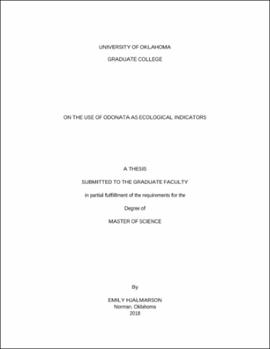| dc.description.abstract | The insect order Odonata, the dragonflies and damselflies, is unique to use as an ecological indicator for water quality because of its close relationship with aquatic ecosystems and relative ease of observation and species-level identification. My goal was to explore ways in which odonates can respond to, and therefore indicate, sites with higher water quality.
Determining where odonates breed as opposed to where they “merely” occur is key to an understanding of the importance of water quality. It has been asserted that one should conclude that an odonate species breeds if and only if physical (exuvia, tenerals) or behavioral (tandem pairing, oviposition) evidence is obtained, yet gathering such evidence requires specialized observational and technical skills. In contrast, reliable observations and counts of adults can be had readily, creating a dilemma over which data to use. For my first chapter, I examined whether adult surveys and reproductive behaviors could predict breeding residency status, represented by presence of tenerals (newly emerged odonates), using a large, multi-year dataset from across Oklahoma. Using an occupancy model combined with piecewise regression, I found thresholds and associated Bayesian credible intervals for a suite of odonate taxa. I found similar general thresholds across species but found specific indicator thresholds exist when examining groups on the family and genus level. Thresholds differed among taxonomic groups and decreased in models that included counts of females rather than just of counts of adults any (or unknown) sex. My results can guide future survey protocol: adult observations can remain the primary focus, which broadens the scope of potential observer skill levels (e.g., citizen scientists) while indirectly ensuring breeding to identify sites for water quality surveys.
For my second chapter, I examined odonate biodiversity at urbanized water features to determine factors that promote species diversity and abundance, with a goal of using findings to make beneficial improvements to park management to increase water quality. I conducted surveys April–October 2016–2017 at 14 urban sites in central Oklahoma that varied in human use and habitat structure. I compared diversity and species composition among sites and tested which features best predicted higher abundance and species totals. Several variables were good predictors but use of a site for fishing purposes was an overarching indicator of both high species richness and high odonate abundance. Despite higher human use, presence of infrastructure, and increased management of these sites (which are typically negatively associated with biodiversity), odonates (and humans) benefit from maintaining them and ensuring proper water quality persists (i.e., if it is good for fish, it is good for insects). | en_US |
